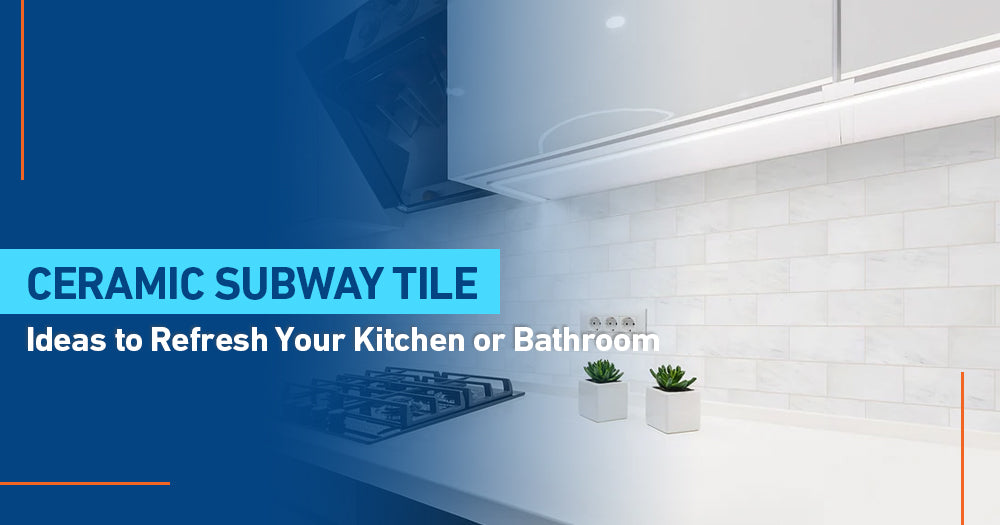If you’re looking to refresh your kitchen or bathroom with a timeless yet stylish upgrade, ceramic subway tiles are a fantastic option. These versatile and durable tiles offer countless design possibilities, making them perfect for nearly any space. Whether you're renovating a tired backsplash or creating a stunning shower feature wall, ceramic subway tiles can elevate the aesthetic of your home with their clean lines and sleek appeal.
In this comprehensive guide, we'll explore a variety of ceramic subway tile ideas, including how to use them in both the kitchen and bathroom. From classic white subway tiles to vibrant colors and unique patterns, you’ll discover how to make the most of this ever-popular tile style. Plus, we'll highlight some options available at Tile Hub, a sister company of Pebble Tile Shop, which offers premium tile solutions for all your home renovation needs.
What Makes Ceramic Subway Tiles So Popular?
Before we dive into ceramic subway tile ideas, let’s take a moment to understand why these tiles have remained so popular. The original subway tile was first used in the early 1900s in New York's subway stations. It was chosen for its simple, rectangular shape and easy-to-clean surface, which made it ideal for high-traffic areas. Today, ceramic subway tiles have become a staple in kitchens and bathrooms due to their aesthetic appeal, durability, and ease of maintenance.
The beauty of ceramic subway tiles lies in their timeless design. These tiles come in a variety of finishes, colors, and textures, allowing homeowners to achieve both modern and classic looks. Whether you prefer the traditional white or a more daring color scheme, ceramic subway tiles will fit seamlessly into any design style.
Classic White Ceramic Subway Tiles: A Timeless Choice
When it comes to ceramic subway tile ideas, the classic white subway tile is an undisputed favorite. This tile has been the go-to choice for kitchens and bathrooms for decades. Its simplicity allows it to blend with a wide range of design styles, from sleek modern interiors to more rustic or vintage-inspired spaces.
In the kitchen, classic white subway tiles can create a bright and clean backdrop, especially when paired with dark cabinetry or colorful countertops. They make an excellent backsplash for any kitchen, offering a crisp and fresh look without overpowering other elements of the room. For a bit of added flair, you can install the tiles with a contrasting grout color, such as black or grey, to create a more striking effect.
In the bathroom, white subway tiles can be used to cover walls or as a shower surround. Their reflective quality can make smaller spaces feel larger and more open, making them ideal for compact bathrooms. White tiles are also incredibly easy to maintain, making them a smart choice for high-moisture areas.
Bold and Vibrant Ceramic Subway Tile Ideas
While white subway tiles are classic and timeless, there’s no reason you can’t experiment with bold colors to add personality and character to your kitchen or bathroom. Vibrant shades like navy blue, emerald green, or even fiery red can infuse your space with energy and charm.
Consider using bold ceramic subway tiles as an accent wall in the kitchen to create a focal point behind the stove or sink. This design approach works particularly well in open-plan kitchens, where the tiles can serve as a conversation starter. In the bathroom, a colorful subway tile backsplash or shower wall can create a visually striking contrast against neutral fixtures and fittings.
Another trend worth exploring is using two contrasting colors of ceramic subway tiles. For example, alternating between white and navy blue tiles can create a nautical-inspired aesthetic that feels fresh and modern. This approach works particularly well in smaller kitchens and bathrooms, where you want to create interest without overwhelming the space.
Herringbone and Chevron Patterns with Subway Tiles
If you’re looking for something a little more dynamic, try experimenting with different laying patterns for your ceramic subway tiles. Herringbone and chevron patterns have become hugely popular in recent years and can add an elegant touch to your kitchen or bathroom.
A herringbone pattern is created by arranging the tiles in a V-shaped formation, where each tile is angled at 45 degrees. This layout works beautifully in both traditional and contemporary spaces, giving your design a timeless yet modern feel. You can use a herringbone pattern in the bathroom on the floor, shower walls, or as a backsplash behind the vanity. In the kitchen, consider a herringbone design behind the stove or sink for added visual interest.
Chevron patterns, on the other hand, are made by placing the tiles at a 90-degree angle to form a zigzag design. This bold layout creates a sense of movement and flow, making it ideal for larger spaces. If you want to make a statement in your bathroom, use chevron-patterned subway tiles to create an eye-catching feature wall in the shower area. For the kitchen, consider using this design on the floor or as a backsplash to bring energy and visual excitement to the space.
Mixing and Matching Textures with Ceramic Subway Tiles
One of the most exciting ceramic subway tile ideas is to mix and match different textures and finishes. Glossy and matte tiles can be combined to create a striking contrast, while textured subway tiles can add depth and dimension to your design.
In the bathroom, matte ceramic subway tiles can create a sophisticated, spa-like ambiance, while glossy tiles in the kitchen will reflect light and brighten up the space. Textured tiles, such as those with a raised pattern or 3D effect, can be used as an accent wall or backsplash to add a unique touch to your design. For example, consider using textured tiles in a neutral tone as a contrast to a smooth, glossy tile layout.
Another way to experiment with texture is by using subway tiles in different materials. For example, pairing ceramic subway tiles with natural stone accents can create a rich and luxurious look in both the kitchen and bathroom. The combination of ceramic and stone textures will bring a unique feel to your space that’s both practical and aesthetically pleasing.
Subway Tiles with a Touch of Luxury: Marble and Glass Subway Tiles
For a more upscale look, consider integrating marble or glass tiles into your design. These materials bring sophistication and elegance to any room, elevating the overall aesthetic. Marble subway tiles, with their unique veining patterns, can make your kitchen or bathroom feel luxurious and timeless.
In the kitchen, a marble subway tile backsplash can complement granite countertops, creating a seamless and polished look. In the bathroom, marble subway tiles can be used in the shower or on the floor to achieve a high-end, spa-like atmosphere. Pairing these tiles with sleek fixtures and minimalist designs will allow the marble subway tiles to shine as the focal point of the room.
Glass subway tiles, on the other hand, add an element of transparency and lightness. They can be used in combination with ceramic subway tiles to create an interesting juxtaposition. Glass tiles are available in a variety of colors and finishes, including frosted, transparent, and iridescent. These tiles are perfect for creating a reflective, light-filled space, making them ideal for smaller kitchens or bathrooms that need a bit of extra brightness.
How to Install Ceramic Subway Tiles
Installing ceramic subway tiles may seem like a daunting task, but it’s relatively straightforward for those with basic DIY skills. Here’s a brief overview of how to install ceramic subway tiles in your kitchen or bathroom:
- Preparation: Start by cleaning the surface where the tiles will be installed. Make sure it’s smooth and free from dirt or grease.
- Layout: Plan your tile layout by measuring the area and marking guide lines. This will ensure that your tiles are installed evenly.
- Cutting Tiles: If needed, use a tile cutter to trim the tiles to fit around edges or corners. For curved edges, you may need a wet saw.
- Adhesive Application: Apply tile adhesive to the wall or floor using a notched trowel. Be sure to cover the area evenly.
- Placing Tiles: Start placing the tiles, leaving small gaps between each tile for grout. Use tile spacers to maintain consistent spacing.
- Grouting: Once the adhesive has dried, apply grout to fill the gaps between the tiles. Use a grout float to smooth the grout into the spaces.
- Sealing: After the grout has dried, apply a sealant to protect your tiles and grout from stains and moisture.
Conclusion
As you can see, ceramic subway tiles are a versatile and timeless choice for both kitchens and bathrooms. Whether you’re opting for a classic white look or experimenting with bold colors and unique patterns, these tiles can completely transform your space. From herringbone designs to textured finishes, the possibilities are endless.
If you're looking for high-quality ceramic subway tiles for your next renovation project, visit Tile Hub, a trusted sister company of Pebble Tile Shop, where you can find an excellent selection of tiles for all your design needs.
For more information, visit Tile Hub today and explore our diverse range of tile options to refresh your home.







